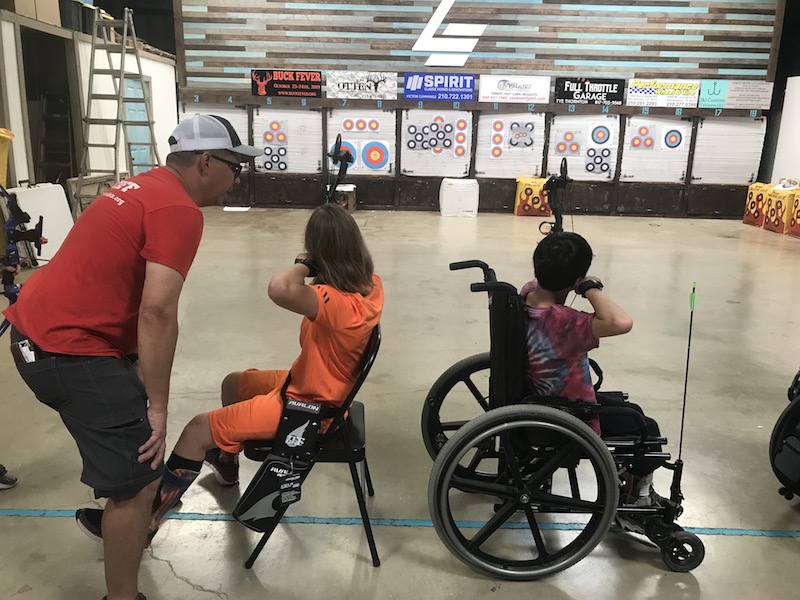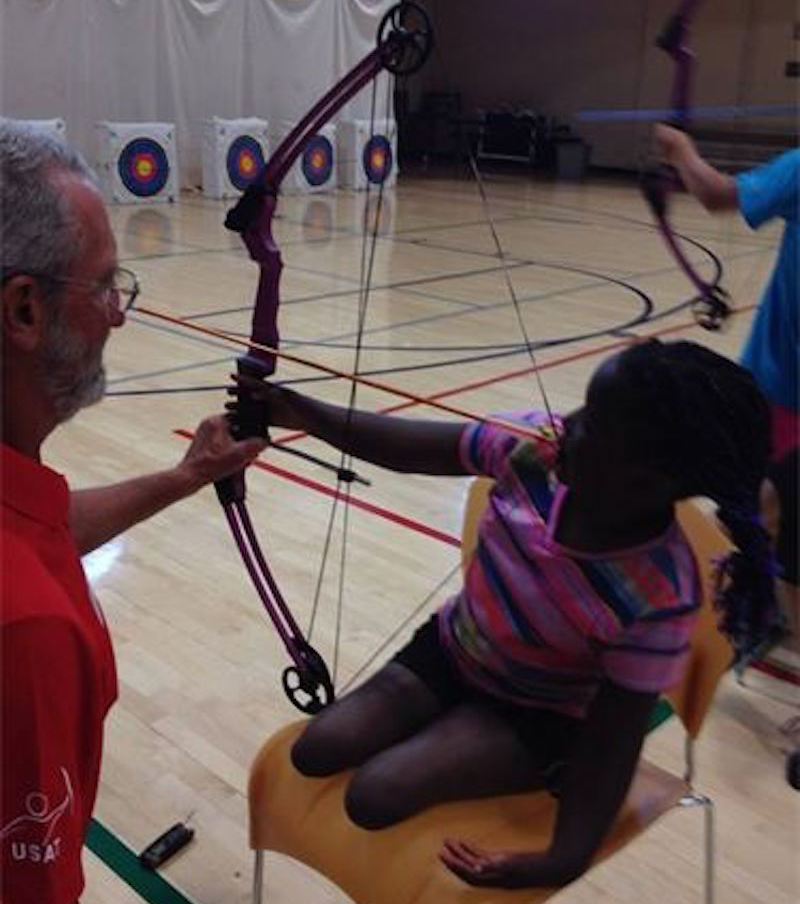Retail
Adaptive Archery, Part 1: Adapt Your Shop
Making your shop accessible to para-archers will generate adaptive archery programs.
Photo Credit: ATA
Para-archers continue to shatter records in tournaments at the state and World Archery levels. Maybe that’s because the possibilities for adapting equipment are nearly endless, providing solutions for every para-athlete who wants to try archery. If you own an archery shop and you want to expand its offerings, para-archery needs to be on your agenda.
Roger Koss, S3DA Texas state coordinator, coaches adaptive archery through Kinetic Kids in San Antonio. When Koss was a graduate student at the University of the Incarnate Word, he asked Scott LeBlanc, the school’s director of sports and wellness, if he could use its facilities to host archery programs. LeBlanc agreed, and the program soared.

Koss coaches young archers at a Kinetic Kids lesson at Leading Edge Archery in Boerne, Texas. Photo Credit: ATA
Koss thinks shop owners would be surprised by the interest in their area. As the iconic line in “Field of Dreams” suggested: If you build it, they will come. “If you think you don’t have enough people in your area for a program, it’s only because they don’t know about your venue,” Koss said. “The interest is there. The participants just need a location.”
If your shop is accessible to wheelchairs, you can offer adaptive archery. If not, you’re turning away para-archers, says Jason Tabansky, a coach and Team USA para-archer. “If I literally can’t get in the door of an archery shop, I have no choice but to shoot somewhere else,” he said.

Tabanksy competes in a Leading Edge team shirt. Photo Credit: USA Archery
Tabansky recalls wanting to practice before a tournament, but a shop’s door was atop a set of steps. He knew others who shot there, however, and they helped him through the door. If they hadn’t been there, Tabansky would have practiced elsewhere.
Shop owners looking to adapt their shop can breach such barriers fairly easily, however. Make sure you have a ramp available if your shop has a raised entrance. Make sure your doors are wide enough to accommodate a wheelchair.
Tabanksy also said shooting at ranges without an accessible bathroom makes the experience more difficult. Clear space underneath the sink to allow room for a seated patron’s knees. Make sure the center of the toilet is 16-18 inches away from the side wall and is 17-19 inches high. View a brief list of measurements here and visit the ADA’s website for the complete standards.
Scott Hamlin, owner of Leading Edge Archery in Boerne, Texas, where Koss and Tabansky shoot, sought and followed Tabansky’s advice to make his shop’s bathroom accessible to wheelchairs when changing locations.
That accessible space enabled Tabansky to coach fellow para-archer Eric Lindsay, vice president and legislative director of the Paralyzed Veterans of America Texas Chapter. Both men are military veterans who served in the Army and met when rehabilitating from different injuries in the same hospital. Lindsay could barely shoot a 15-pound Genesis bow when he started. Tabansky helped him gain strength by drawing the bow 10 times in a row, like a rep in a gym.
Tabansky said he’ll never forget the look on Lindsay’s face when he finally shot an arrow. He now shoots a Prime Logic bow using his jaw/cheekbone to trigger the release-aid, and adds putty in the grip to help keep his hand in place.
The key to adaptive archery is assessing and addressing each archers’ unique needs. “I once had someone send me a video of a young girl trying to shoot adaptive archery, and they asked what they should do to help her,” Tabansky said. “I looked at it and immediately said, ‘Oh, she just needs to be strapped in.’” Positioning archers to shoot from their wheelchair, and then strapping them into place is a simple adaptation shop owners might not recognize. It can easily be done with help from a para-archery coach.

WE ARE HERE TO HELP THE INDUSTRY, TO HELP INDIVIDUAL BUSINESSES GET THE MOST OUT OF THE INDUSTRY, AND TO HELP YOU.

Rogers coaches Hanna Cann at the Endeavor Games. Photo Credit: ArcheryResources.net
M.J. Rogers, coach of the USA Paralympic archery team, stresses friendly, inviting communication. “Don’t ask any intrusive questions,” Rogers said. “Just go up to the person and say, ‘Would you be interested in learning how to shoot archery?’”
Some disabled athletes might not know they can shoot archery. And some shop owners might not know how to adapt archery. If knowledgeable para-athletes connect with unaware shop owners, and knowledgeable shop owners connect with unaware para-athletes, every city could offer adaptive archery programs.
If your building is not ADA-compliant, renovation costs might hold you back. This hurdle is understandable, but you can contact various organizations for financial help. The Challenged Athletes Foundation and Blaze Sports provide grants and instructional videos to help archery shops adapt. CAF awards its grants in the athlete’s name, but the archer can give the money to an archery shop.
If you need help writing grant proposals, contact a university to see if any students need experience writing them. This team-building approach gives students a project that earns college credit while helping you apply for grants. Here’s another team-building idea: Scouts need to participate in service projects, so ask if a local troop would build a ramp or other project to help adapt your shop for para-archers.
The ATA also offers range grants for shops, and asks applicants to provide an example of how they would use the money. Adapting a shop for para-archers is a great example. View our Grant page for more information.
Also contact S3DA, USA Archery, Paralympic Sports Clubs, or the Disabled Athlete Sports Association to connect with a para-archer. Disabled Sports USA has a chapter in every state.
Also feel free to email Koss and Tabansky to discuss your options. You can reach them at Roger.J.Koss@gmail.com and JasonTabansky@gmail.com.
Once you connect, the door is open. Programs and individual para-archers can offer advice on your programs, suggestions for your shop, and contacts they’ve met in the circuit. As you create and expand your network, the rest will fall into place.
In Part 2 of this adaptive archery series, we'll explore coaching adaptive archery programs and highlight programs providing adaptive archery. Click here to read Part 2.
